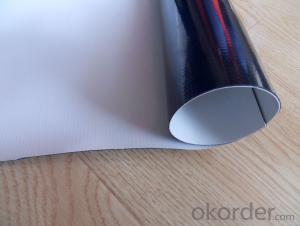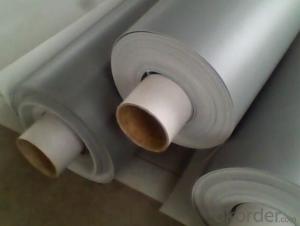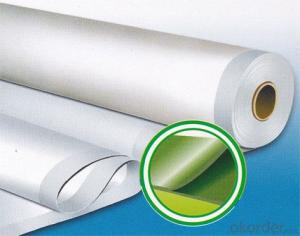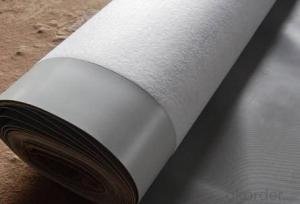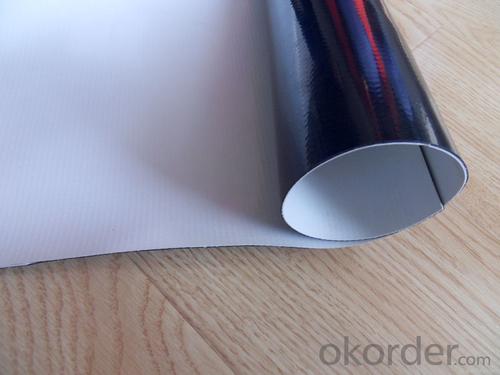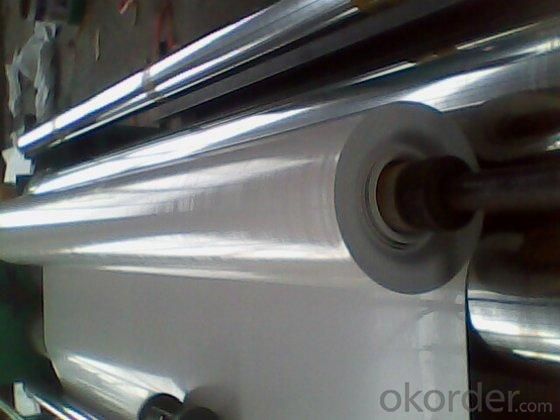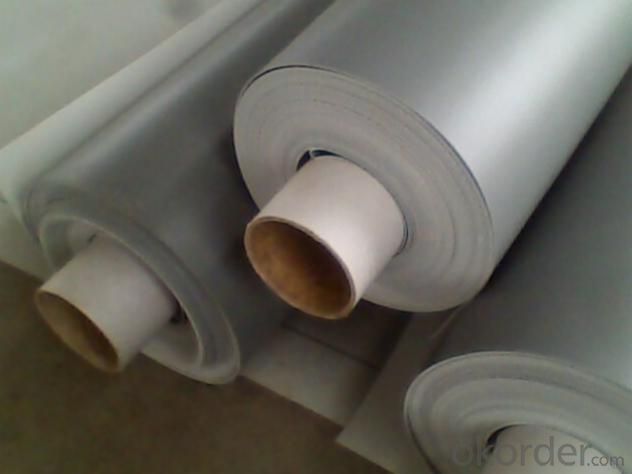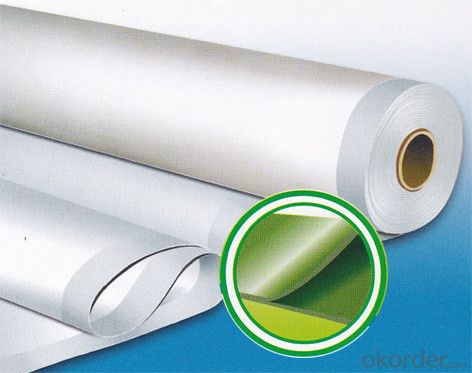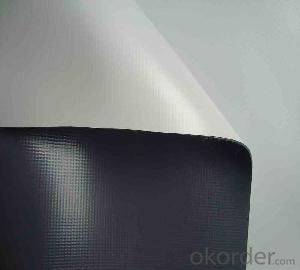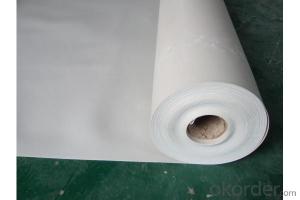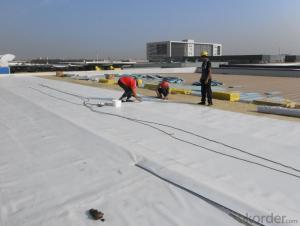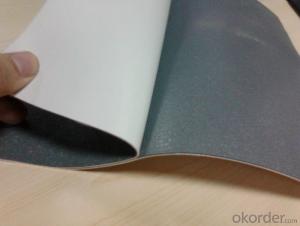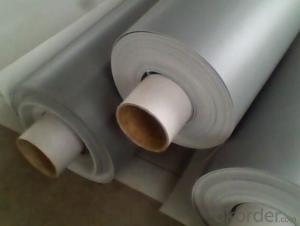PVC Waterproofing Membrane with Fiberglass Reinforcement
- Loading Port:
- Shanghai
- Payment Terms:
- TT OR LC
- Min Order Qty:
- 20000 m²
- Supply Capability:
- 5000000 m²/month
OKorder Service Pledge
OKorder Financial Service
You Might Also Like
PVC Waterproofing Membrane with Fiberglass Reinforcement
Product Description of PVC Waterproofing Membrane with Fiberglass Reinforcement:
PVC Membrane Waterproof /Waterproofing membrane For Roof is a new polymer waterproof membrane. The PVC Membrane Waterproof /Waterproofing membrane For Roof raw material is polyvinyl chloride resin, mixed with plasticizer, filler, antioxygen, ultraviolet absorber and other auxiliaries.
Thickness: 1.2mm/1.5mm/1.8mm/2.0mm
Width:2050mm
Length:20m( Special specifications can be customized)
Size: 2.05mx20m
Color: white/grey, or any other colors.
Features of PVC Waterproofing Membrane with Fiberglass Reinforcement:
1. Excellent anti-aging property.
2. Puncture- resistant.
3. Welding construction,
4. High tensile strength, good elongation, good dimensional stability.
5. Good plasticity.
6. It has self-extinguishing from fire property.
7. Materials surface is smooth, fast color, stain resistance.
8. More wide, Wastage become less when being used.
Classification of PVC Waterproofing Membrane with Fiberglass Reinforcement:
1. N: Homogeneous PVC membrane
2. L: PVC membrane with fabric backing
3. W: Reinforced PVC membrane
Advantage of PVC Waterproofing Membrane with Fiberglass Reinforcement:
1.) Mixing automation. Apply automatic temperature control automatic time control and automatic feed control.
2.) Extrusion equipment uses twin screw coextrusion. Screw temperature uses computer automatic temperature control system.
3.) Handpiece uses large width didhead extrusion equipment.
4.) Sophisticated three-roller calender equipment. The space between equiment is controlled by automation system.
Technical Data of PVC Waterproofing Membrane with Fiberglass Reinforcement:
No. | Item | Model Ⅱ | |
1 | Tensile Strength Mpa ≥ | 12.0 | |
2 | Elongation at break% ≥ | 250 | |
3 | Shrinkage rate % ≤ | 2.0 | |
4 | Flexibility at low temperature | No crackle at -25oC | |
5 | Water tightness | Watertight | |
6 | Puncture resistance | Watertight | |
7 | Heat aging treatment | Appearance | Free from bubble, crack, cohesion and void |
Change rate of tensile strength % | +20oC | ||
Change rate of elongation at break | |||
Flexibility at low temperature | No crack at -20oC | ||
8 | Chemical corrosion resistance | Change rate of tensile strength % | +20 |
Change rate of elongation at break | |||
Flexibility at low temperature | No crack at -20oC | ||
9 | Artificial weathering | Change rate of tensile strength % | +20 |
Change rate of elongation at break | |||
Flexibility at low temperature | No crack at -20oC | ||
Application of PVC Waterproofing Membrane with Fiberglass Reinforcement:
1) All kinds of roofs, such as steel structure roof, planted roof etc.
2) Underground engineering, such as building basement, subways, tunnels, air raid shelter, etc.
3) Other projects like artificial lake, dam, water reservoir, grain storehouse, etc.
Images of PVC Waterproofing Membrane with Fiberglass Reinforcement:
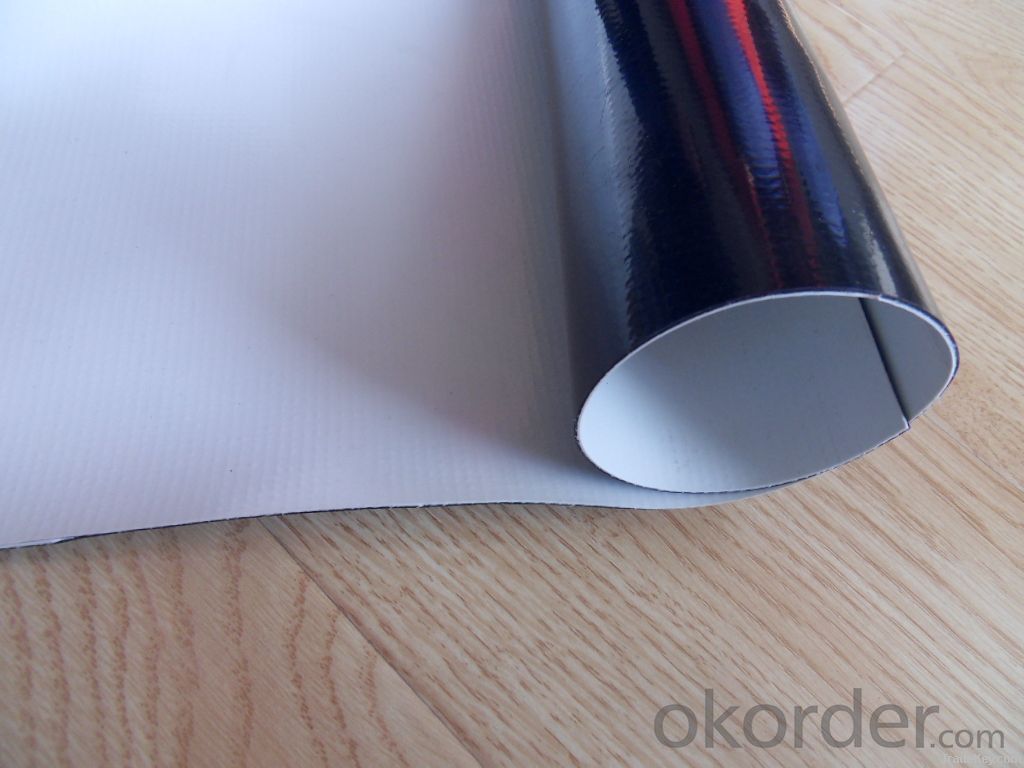
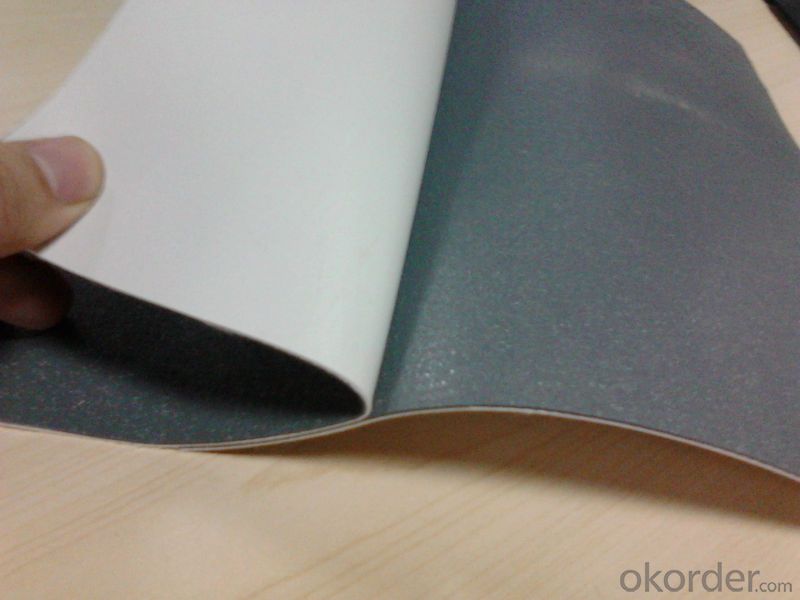
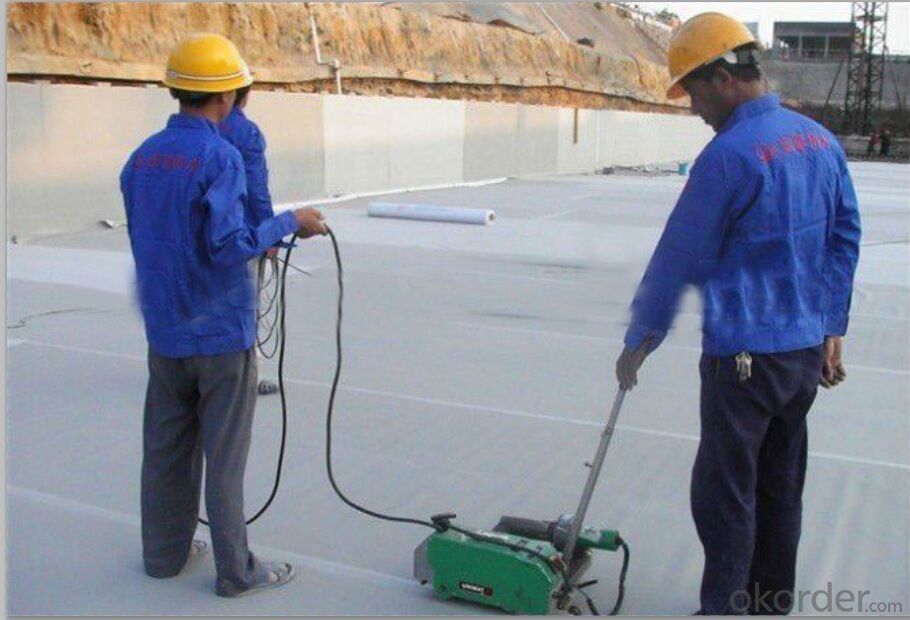
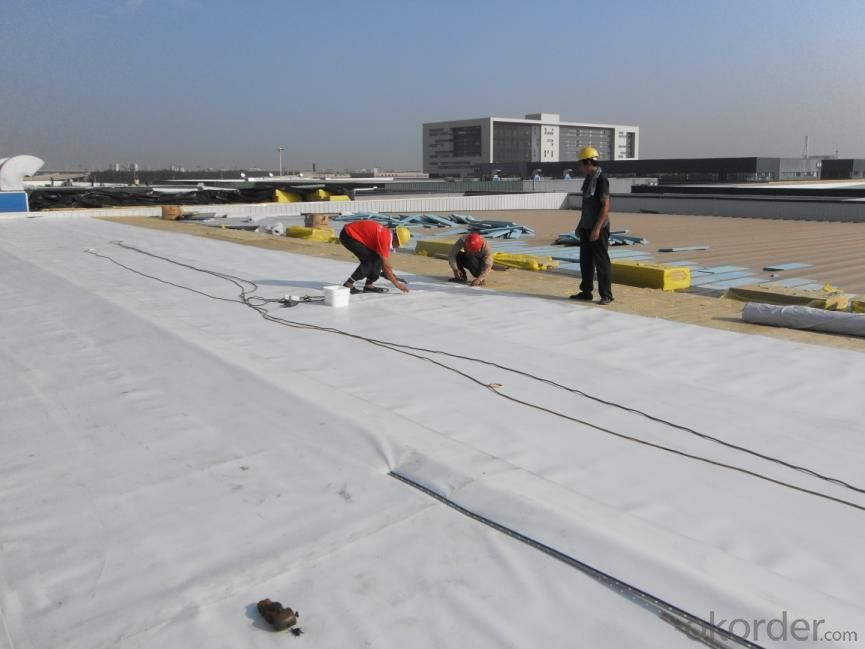
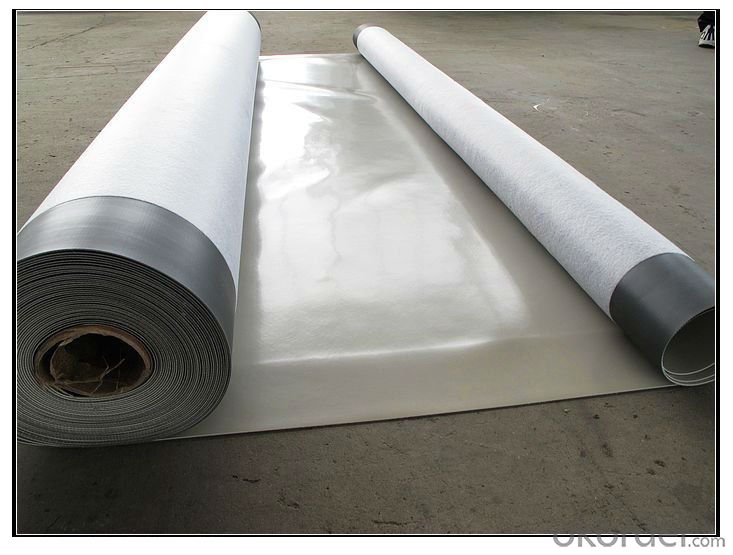
FAQ:
1. Can you produce 4m width?
Yes, no problem for us. We have four bases in China, largest one in this field.
2. How many quantity in one 20'' container for 1.2mm and 1.5mm?
480rolls, 11520m2 for 1.2mm and 400rolls, 9600m2 for 1.5mm
3. Can you provide free samples?
Yes, our samples are free, but express fees usually on buyer's account.
- Q: Can a waterproofing membrane be used in areas with high foot traffic?
- Areas with high foot traffic can indeed benefit from the use of a waterproofing membrane. These membranes are designed to safeguard against water and moisture, making them suitable for a range of environments, including those that experience heavy foot traffic. In fact, commercial buildings such as shopping malls, hospitals, and office complexes frequently utilize these membranes due to the constant flow of people. However, it is crucial to select the appropriate type of waterproofing membrane specifically designed for high foot traffic areas. Certain membranes possess enhanced durability and resistance to wear and tear, making them an excellent choice for such environments. Furthermore, proper installation and maintenance are essential to ensure the longevity and effectiveness of the membrane in areas with heavy foot traffic. It is also advisable to consider the unique requirements of the area and consult professionals or manufacturers to determine the most suitable waterproofing membrane for the given conditions. By carefully selecting and expertly installing the membrane, one can effectively shield areas with high foot traffic from water damage and ensure their longevity.
- Q: Can a waterproofing membrane be used on roofs or only on vertical surfaces?
- Both roofs and vertical surfaces can benefit from the use of a waterproofing membrane. It is a common practice to utilize this membrane to safeguard roofs against water-related harm. Specifically designed as a barrier against water infiltration, roofing membranes guarantee a dry and leak-free structure. These membranes are applied to the roof's surface, forming a protective layer that prevents water from seeping through. In a similar manner, waterproofing membranes can also be employed on vertical surfaces, such as walls, to prevent water ingress and safeguard the underlying structure. The primary objective of a waterproofing membrane is to establish a watertight seal, regardless of whether it is used on a horizontal or vertical surface. Therefore, whether it is a roof or a vertical wall, a waterproofing membrane is an effective solution for shielding against water damage.
- Q: Can a waterproofing membrane be used for a basement floor?
- Yes, a waterproofing membrane can be used for a basement floor. Waterproofing membranes are designed to prevent water from seeping through the surface and reaching the underlying structure. By applying a waterproofing membrane to the basement floor, it creates a barrier that helps to keep the floor dry and prevent water damage. This is particularly important in basements, as they are commonly prone to water infiltration due to their location below ground level. Additionally, a waterproofing membrane can also help to reduce the risk of mold and mildew growth, as moisture is effectively sealed out. It is important to choose a high-quality waterproofing membrane that is specifically designed for basement floors and to follow the manufacturer's instructions for proper installation.
- Q: Can a waterproofing membrane be applied to horizontal surfaces?
- Yes, a waterproofing membrane can be applied to horizontal surfaces.
- Q: Can a waterproofing membrane be used on precast nickel surfaces?
- Yes, a waterproofing membrane can be used on precast nickel surfaces. The membrane will provide a protective barrier against water penetration, helping to prevent moisture damage and corrosion on the nickel surface.
- Q: Can a waterproofing membrane be used on metal block surfaces?
- Yes, a waterproofing membrane can be used on metal block surfaces. Waterproofing membranes are designed to create a barrier against water and moisture, and they can be applied to a variety of surfaces, including metal. The membrane will adhere to the metal surface, creating a waterproof layer that helps prevent water infiltration and protect the metal from rusting or corrosion. However, it is important to ensure that the metal surface is clean, dry, and properly prepared before applying the waterproofing membrane to ensure proper adhesion and effectiveness. Additionally, it is recommended to consult with a professional or refer to the manufacturer's instructions for specific guidance on using a waterproofing membrane on metal block surfaces.
- Q: Can a waterproofing membrane be used on both interior and exterior surfaces of a structure?
- Yes, a waterproofing membrane can be used on both interior and exterior surfaces of a structure. Waterproofing membranes are designed to create a barrier that prevents water or moisture from penetrating into the structure, whether it is applied on the inside or outside. On the interior, a waterproofing membrane can be used to protect basements, crawl spaces, or other areas prone to moisture intrusion. This helps to prevent water damage, mold growth, and other issues that can arise from excess moisture in these spaces. On the exterior, a waterproofing membrane is commonly used to protect the foundation, walls, and other structural elements from water infiltration. This is especially important in areas with heavy rainfall or where the water table is high. By applying a waterproofing membrane on the exterior, it helps to keep the structure dry and prevents potential damage caused by water seepage. It is important to note that different types of waterproofing membranes are available for specific applications, so the selection of the appropriate membrane will depend on the specific requirements of the project.
- Q: Can a waterproofing membrane be used on precast insulation surfaces?
- Indeed, precast insulation surfaces can make use of a waterproofing membrane. The primary purpose of this membrane is to create a safeguard against water infiltration, and it can be applied to diverse surfaces, such as precast insulation. In effect, the membrane serves to thwart water from penetrating the insulation, thereby averting potential harm and preserving its efficacy. By employing a waterproofing membrane on precast insulation surfaces, one can guarantee that the insulation stays dry and preserves its thermal properties for the long term.
- Q: Can a waterproofing membrane be used on crawl spaces?
- Yes, a waterproofing membrane can be used on crawl spaces. Crawl spaces are often prone to moisture and water issues, which can lead to mold growth, structural damage, and other problems. Installing a waterproofing membrane can help prevent water from seeping into the crawl space, keeping it dry and protected. The membrane is typically made of a durable and flexible material that can withstand the conditions of a crawl space. It is installed on the walls and floor of the crawl space, creating a barrier against moisture. This can be especially beneficial in areas with high groundwater levels, heavy rainfall, or homes located in flood-prone areas. Additionally, a waterproofing membrane can help improve indoor air quality by preventing the growth of mold and mildew, which thrive in damp environments. Overall, using a waterproofing membrane in crawl spaces is an effective way to prevent water damage and maintain a healthy living environment.
- Q: Can a waterproofing membrane be used on plastic block surfaces?
- Indeed, it is possible to utilize a waterproofing membrane on surfaces composed of plastic blocks. These membranes are specifically engineered to serve as a safeguard against moisture, effectively hindering water infiltration. Similar to any other type of surface, plastic blocks are prone to water-related harm if not adequately shielded. By applying a waterproofing membrane, one can successfully seal and safeguard the plastic blocks, thus thwarting water permeation and potential destruction. To achieve optimal outcomes, it is crucial to select a waterproofing membrane that harmonizes with plastic materials and adhere to the manufacturer's application guidelines.
Send your message to us
PVC Waterproofing Membrane with Fiberglass Reinforcement
- Loading Port:
- Shanghai
- Payment Terms:
- TT OR LC
- Min Order Qty:
- 20000 m²
- Supply Capability:
- 5000000 m²/month
OKorder Service Pledge
OKorder Financial Service
Similar products
Hot products
Hot Searches
Related keywords
